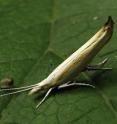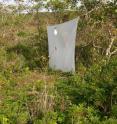Catch me if you can: 2 new species of moth from the Russian Far East
Related images
(click to enlarge)
Ypsolophid moths are a peculiar group of Lepidoptera that attracts attention with their strange preference for a pose of rest. To take a break adult Ypsolophids like to go bottom up with antennae stretched forward. The larvae of these quirky species live and feed in webs they form on the leaves, buds and twigs of plants. When they are ready to pupate they produce a cocoon like cradle attached to the host plant. This bizarre group of moths is also particularly hard to catch. The standard methods for collecting adults, usually comprising of breeding them from larvae or attracting the adults by light, both work rarely in the case of Ypsolophids. The larvae of most species usually live solitary on host plant and are hard to find in nature and unlike most flying insects, adults of many species fly on light infrequently. Thus the collecting of specimens from this group is big event for entomologists, especially if the species caught turns out to be unknown for science. Russian scientists have had the rare luck to catch and describe two new species of ypsolophid moths from the south regions of the Russian Far East. The study was published in the open access journal ZooKeys.
Being thermophilic, Ypsolophid moths represent a group that has a propensity for relatively higher temperature of the southern regions of the Russian Far East. During last decade the number of known species from Russian Far East has been more than twice increased. Including the species described in this paper, they reached the number of 30 species, which makes for a fourth of all known Ypsolophids worldwide.
"Faunistic studies are not only a whim! Exploring species diversity is a task with ecological repercussions on a local, and global scales," explains Dr. Ponomarenko, Institute of Biology and Soil Science, Far Eastern Branch of Russian Academy of Science. "Studying the species diversity in East Asia as a whole and in the Far East of Russia in particular is an important endeavour. Faunistic investigations are only the first step in a long row of scientific tasks towards forming a primary database for further theoretical reconstructions and conclusions for the benefit of biodiversity conservation and species preservation."
Source: Pensoft Publishers
Other sources
- Catch me if you can: Two new species of moth from the Russian Far Eastfrom Science DailyWed, 17 Apr 2013, 0:30:36 UTC
- Catch me if you can: Two new species of moth from the Russian Far Eastfrom PhysorgTue, 16 Apr 2013, 15:31:03 UTC


